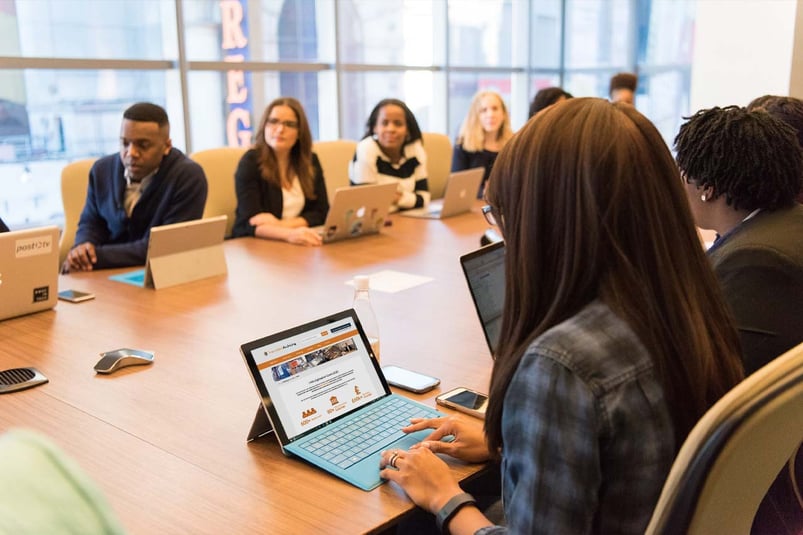Last Updated: 18th January 2021
Archive digitisation projects can require a lot of resources: staff, volunteers, equipment, time, and, of course, financial resources. This is particularly true if you choose to carry out your project entirely in-house, but also to a lesser extent if you partner with an external digitisation provider.
So whichever way you choose to approach your digitisation project, you will likely need the support of a number of internal stakeholders to obtain the resources you need and get your project off the ground - from your immediate service or department manager through to marketing/communications staff or I.T.
Each of these stakeholders will have their own goals and they may not perceive these as aligned with those of your digitisation project. They may even have their own concerns about your project.
So how do you gain the support of these stakeholders and move your digitisation project forward?
Look at each stakeholder’s specific concerns, and consider how your digitisation project could help them achieve their own goals. Ask yourself “What's in it for them?” To help, below we’ve shared some typical concerns that our clients have encountered from different stakeholders – together with strategies for winning them over and getting them to buy into your project.
Finance:
"Digitisation is too expensive, where is the return?”
Whilst you may be able to source funding for your digitisation project from external foundations and charities (HLF, Andrew W Mellon, TWA Digitisation Grant etc), often these will not completely cover project costs. In addition, you may not always be eligible to apply for these funding streams, particularly if you work for a business or private archive.
In this case you may need to directly, or indirectly through your management, persuade finance that your scanning project deserves the budget required.
Your colleagues in Finance may struggle to see the cost effectiveness of digitisation, and view it as a high cost investment with little return. Here, explaining and showing the potential long term savings and possibilities for revenue generation will aid your case.
Having digitised records can mean faster look-ups (due to quick access and keyword searching), resulting in staff spending less time researching in response to user queries, allowing them more time to focus on other responsibilities.
In addition, online archive revenue generation options like pay-per-record downloads, selling physical print reproductions, or digital subscription services, can offset the initial costs of digitisation over time. To support your case, share examples of other similar revenue generating digitisation projects, demonstrating digitisation as a viable option.
However, some may still need convincing, especially with higher value projects. In these cases, suggesting a pilot project may be the way forward. Generally working out as smaller financial commitments, pilot projects can also help estimate costs for a future, larger project.
IT:
“You need how many extra machines?! Where are we going to store 2TB of images?”
The support of your IT colleagues is vital, particularly if you plan to digitise your collection in-house and if you plan on making the collection accessible online. They might have reservations about your digitisation project. Some of these will be around digitising itself, whilst others will relate more to the storing of digital images and publishing them online (if that is part of your project aims).
If you plan on digitising in-house, IT will normally need to provide the computer equipment you require to carry out the scanning (or obtain it using their budget), but they may well have preferable plans for those machines and/or funds.
The only option here is to explain the value of digitisation to your heritage service/business and be flexible about the number/type of equipment required, as much as possible. An alternative solution, of course, would be to have an external provider digitise the materials, removing the need for internal IT equipment. However, this may increase project costs.
Another IT concern may be about safely storing and accessing your digitised files, and the large amount of space your collection would occupy on your organisation’s servers and any possible implications this might have for your existing website.
And what about if you are planning to put your digitised archive online? You will need to persuade IT that digitisation won’t involve a lot more work. Remember, a digitised archive doesn’t necessarily mean a new website - in most cases your digitised collection could integrate into your organisation’s current website. This means minimal hassle without any additional security risk.
Marketing/Communications:
“It’s not really our area”
Getting your Marketing or Communications colleagues to support your digitisation project is key, as they will likely be essential in your outreach activities, promoting the digital resources that your project creates.
Whether you are working as part of a local authority archive, museum, or corporate business, your marketing colleagues will almost certainly have a shared objective for generating media attention and engaging potential service users and customers.
Depending on the content of the collection(s) to be digitised, you might be able to share some of the digital content via a dedicated project blog, your organisation’s social media accounts, or other channels, thereby increasing awareness and engagement with your collections.
Explaining how your project can assist the marketing and communications team in achieving their objectives should immediately have them getting behind your project. You may even be able to persuade the marketing department to contribute some of their budget towards your scanning project to increase its scope.
A note to corporate and brand archivists: marketing departments are increasingly recognising the importance of brand heritage. As such, it might be beneficial to point out the opportunity to use the digitised archive in advertising and promotional campaigns.
Human Resources:
“I don’t see that it affects us”
Your colleague(s) in Human Resources may initially be indifferent to the idea of your digitisation project. But if, as in many cases, it will be their responsibility to recruit and induct any new staff or volunteers for the project, they may simply view it as creating additional work.
As with the other stakeholders above, the key to getting HR on board with your project is showing that it can help them achieve their own goals.
Even though digitisation is no longer seen as new, creating online digital collections, making them accessible via intuitive web portals, and digitally preserving these images is innovative, opening up so many opportunities for potential.
Engaging in digital projects like these could help foster a positive perception of your organisation as a modern, forward-thinking one. This, in turn, could help draw candidates to your organisation; making recruitment easier and likely improving employee retention. In fact, not engaging in digitisation projects may cultivate a more negative perception of the organisation in a time when people almost expect everything to be available online.
Management: “What impact will this digitisation project have?”
The focus and scope of management’s role (and indeed their job title, whether that be Heritage Manager, Head of Archives, etc) will vary depending on where in the heritage sphere your organisation falls. In order to get buy-in from management, you will want to share detailed information on how your proposed digitisation project will impact on, and benefit, all stakeholders in the short term (i.e. throughout the project) and in the long term too.
On one level this will likely mean using the strategies above, to demonstrate how your project will be beneficial for all departmental stakeholders. On another level, this will be shown thorough project planning - including potential sources of funding, timescales, and, if digitising in-house, the equipment needed (or justification for using an external digitisation service).
Are you struggling with a barrier we haven’t covered?
If you’re facing a barrier when it comes to getting buy-in for your heritage digitisation project, and we haven’t addressed it here, contact us or tweet, and we’ll be happy to help you find a solution. Let's get your project started.
Best wishes from everyone at TownsWeb Archiving.



 USE OUR ONLINE
USE OUR ONLINE








